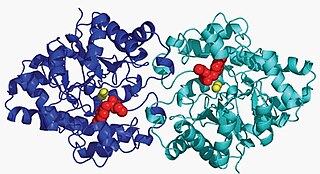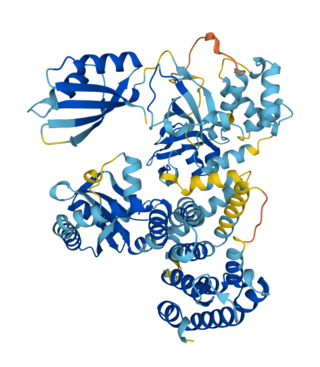Related Research Articles

Polyhydroxybutyrate (PHB) is a polyhydroxyalkanoate (PHA), a polymer belonging to the polyesters class that are of interest as bio-derived and biodegradable plastics. The poly-3-hydroxybutyrate (P3HB) form of PHB is probably the most common type of polyhydroxyalkanoate, but other polymers of this class are produced by a variety of organisms: these include poly-4-hydroxybutyrate (P4HB), polyhydroxyvalerate (PHV), polyhydroxyhexanoate (PHH), polyhydroxyoctanoate (PHO) and their copolymers.

Isopropyl β-d-1-thiogalactopyranoside (IPTG) is a molecular biology reagent. This compound is a molecular mimic of allolactose, a lactose metabolite that triggers transcription of the lac operon, and it is therefore used to induce protein expression where the gene is under the control of the lac operator.

Polyhydroxyalkanoates or PHAs are polyesters produced in nature by numerous microorganisms, including through bacterial fermentation of sugars or lipids. When produced by bacteria they serve as both a source of energy and as a carbon store. More than 150 different monomers can be combined within this family to give materials with extremely different properties. These plastics are biodegradable and are used in the production of bioplastics.

β-Hydroxybutyric acid, also known as 3-hydroxybutyric acid or BHB, is an organic compound and a beta hydroxy acid with the chemical formula CH3CH(OH)CH2CO2H; its conjugate base is β-hydroxybutyrate, also known as 3-hydroxybutyrate. β-Hydroxybutyric acid is a chiral compound with two enantiomers: D-β-hydroxybutyric acid and L-β-hydroxybutyric acid. Its oxidized and polymeric derivatives occur widely in nature. In humans, D-β-hydroxybutyric acid is one of two primary endogenous agonists of hydroxycarboxylic acid receptor 2 (HCA2), a Gi/o-coupled G protein-coupled receptor (GPCR).

Biodegradable plastics are plastics that can be decomposed by the action of living organisms, usually microbes, into water, carbon dioxide, and biomass. Biodegradable plastics are commonly produced with renewable raw materials, micro-organisms, petrochemicals, or combinations of all three.
Fed-batch culture is, in the broadest sense, defined as an operational technique in biotechnological processes where one or more nutrients (substrates) are fed (supplied) to the bioreactor during cultivation and in which the product(s) remain in the bioreactor until the end of the run. An alternative description of the method is that of a culture in which "a base medium supports initial cell culture and a feed medium is added to prevent nutrient depletion". It is also a type of semi-batch culture. In some cases, all the nutrients are fed into the bioreactor. The advantage of the fed-batch culture is that one can control concentration of fed-substrate in the culture liquid at arbitrarily desired levels.

Acetoacetyl CoA is the precursor of HMG-CoA in the mevalonate pathway, which is essential for cholesterol biosynthesis. It also takes a similar role in the ketone bodies synthesis (ketogenesis) pathway of the liver. In the ketone bodies digestion pathway, it is no longer associated with having HMG-CoA as a product or as a reactant.

(p)ppGpp, guanosine pentaphosphate and tetraphosphate, also known as the "magic spot" nucleotides, are alarmones involved in the stringent response in bacteria that cause the inhibition of RNA synthesis when there is a shortage of amino acids. This inhibition by (p)ppGpp decreases translation in the cell, conserving amino acids present. Furthermore, ppGpp and pppGpp cause the up-regulation of many other genes involved in stress response such as the genes for amino acid uptake and biosynthesis.

Aryldialkylphosphatase is a metalloenzyme that hydrolyzes the triester linkage found in organophosphate insecticides:
Poly(3-hydroxybutyrate) depolymerase (EC 3.1.1.75, PHB depolymerase, systematic name poly[(R)-3-hydroxybutanoate] hydrolase) is an enzyme used in the degradation processes of a natural polyester poly(3-hydroxyburate). This enzyme has growing commercialization interests due to it implications in biodegradable plastic decomposition.
The enzyme poly(3-hydroxyoctanoate) depolymerase (EC 3.1.1.76) catalyzes the hydrolysis of the polyester poly{oxycarbonyl[(R)-2-pentylethylene] to oligomers

Bifunctional (p)ppGpp synthase/hydrolase SpoT or SpoT is a regulatory enzyme in the RelA/SpoT Homologue (RSH) protein family that synthesizes and hydrolyzes (p)ppGpp to regulate the bacterial stringent response to environmental stressors. SpoT is considered a "long" form RSH protein and is found in many bacteria and plant chloroplasts. SpoT and its homologues have been studied in bacterial model organism E.coli for their role in the production and degradation of (p)ppGpp in the stringent response pathway.

Poly(3-hydroxybutyrate-co-3-hydroxyvalerate), commonly known as PHBV, is a polyhydroxyalkanoate-type polymer. It is biodegradable, nontoxic, biocompatible plastic produced naturally by bacteria and a good alternative for many non-biodegradable synthetic polymers. It is a thermoplastic linear aliphatic polyester. It is obtained by the copolymerization of 3-hydroxybutanoic acid and 3-hydroxypentanoic acid. PHBV is used in speciality packaging, orthopedic devices and in controlled release of drugs. PHBV undergoes bacterial degradation in the environment.
3-oxo-5,6-dehydrosuberyl-CoA semialdehyde dehydrogenase (EC 1.17.1.7, paaZ (gene)) is an enzyme with systematic name 3-oxo-5,6-dehydrosuberyl-CoA semialdehyde:NADP+ oxidoreductase. This enzyme catalyses the following chemical reaction
Oxepin-CoA hydrolase (EC 3.7.1.16, paaZ (gene)) is an enzyme with systematic name 2-oxepin-2(3H)-ylideneacetyl-CoA hydrolyase. This enzyme catalyses the following chemical reaction
Rhodovulum sulfidophilum is a gram-negative purple nonsulfur bacteria. The cells are rod-shaped, and range in size from 0.6 to 0.9 μm wide and 0.9 to 2.0 μm long, and have a polar flagella. These cells reproduce asexually by binary fission. This bacterium can grow anaerobically when light is present, or aerobically (chemoheterotrophic) under dark conditions. It contains the photosynthetic pigments bacteriochlorophyll a and of carotenoids.
Streptomyces exfoliatus is a bacterium species from the genus of Streptomyces which has been isolated from soil. Streptomyces exfoliatus has the ability to degrade poly(3-hydroxyalkanoate). This species produces exfoliatin and exfoliamycin.
Nocardiopsis aegyptia is a Gram-positive and aerobic bacterium from the genus of Nocardiopsis which has been isolated from marine sediments from the Abu Qir Bay from Alexandria in Egypt. Nocardiopsis aegyptia can degrade poly(3-hydroxybutyrate) (PHB).

β-Butyrolactone is the intramolecular carboxylic acid ester (lactone) of the optically active 3-hydroxybutanoic acid. It is produced during chemical synthesis as a racemate. β-Butyrolactone is suitable as a monomer for the production of the biodegradable polyhydroxyalkanoate poly(3-hydroxybutyrate) (PHB). Polymerisation of racemic (RS)-β-butyrolactone provides (RS)-polyhydroxybutyric acid, which, however, is inferior in essential properties (e.g. strength or degradation behaviour) to the (R)-poly-3-hydroxybutyrate originating from natural sources.

Plastic degradation in marine bacteria describes when certain pelagic bacteria break down polymers and use them as a primary source of carbon for energy. Polymers such as polyethylene(PE), polypropylene (PP), and polyethylene terephthalate (PET) are incredibly useful for their durability and relatively low cost of production, however it is their persistence and difficulty to be properly disposed of that is leading to pollution of the environment and disruption of natural processes. It is estimated that each year there are 9-14 million metric tons of plastic that are entering the ocean due to inefficient solutions for their disposal. The biochemical pathways that allow for certain microbes to break down these polymers into less harmful byproducts has been a topic of study to develop a suitable anti-pollutant.
References
- 1 2 3 Delafield, F. P.; Doudoroff, M.; Palleroni, N. J.; Lusty, C. J.; Contopoulos, R. (November 1965). "Decomposition of Poly-β-Hydroxybutyrate by Pseudomonads". Journal of Bacteriology. 90 (5): 1455–1466. doi:10.1128/jb.90.5.1455-1466.1965. ISSN 0021-9193. PMC 315835 . PMID 5848334.
- 1 2 3 Jendrossek, D (2001-05-01). "Transfer of [Pseudomonas] lemoignei, a gram-negative rod with restricted catabolic capacity, to Paucimonas gen. nov. with one species, Paucimonas lemoignei comb. nov". International Journal of Systematic and Evolutionary Microbiology. 51 (3): 905–908. doi: 10.1099/00207713-51-3-905 . ISSN 1466-5026.
- 1 2 Jendrossek, D; Frisse, A; Behrends, A; Andermann, M; Kratzin, H D; Stanislawski, T; Schlegel, H G (February 1995). "Biochemical and molecular characterization of the Pseudomonas lemoignei polyhydroxyalkanoate depolymerase system". Journal of Bacteriology. 177 (3): 596–607. doi:10.1128/jb.177.3.596-607.1995. ISSN 0021-9193. PMC 176633 . PMID 7836292.
- ↑ Uchino, Keiichi; Katsumata, Yoko; Takeda, Tomoko; Arai, Hiroki; Shiraki, Mari; Saito, Terumi (September 2007). "Purification and molecular cloning of an intracellular 3-hydroxybutyrate-oligomer hydrolase from Paucimonas lemoignei". Journal of Bioscience and Bioengineering. 104 (3): 224–226. doi:10.1263/jbb.104.224.
- ↑ Handrick, René; Reinhardt, Simone; Focarete, Maria Letizia; Scandola, Mariastella; Adamus, Grazyna; Kowalczuk, Marek; Jendrossek, Dieter (September 2001). "A New Type of Thermoalkalophilic Hydrolase of Paucimonas lemoignei with High Specificity for Amorphous Polyesters of Short Chain-length Hydroxyalkanoic Acids". Journal of Biological Chemistry. 276 (39): 36215–36224. doi: 10.1074/jbc.M101106200 .
- ↑ Park, Se Whan; Chung, Moon Gyu; Lee, Hwa Young; Kim, Jeong Yoon; Rhee, Young Ha (December 2008). "Stable expression and secretion of polyhydroxybutyrate depolymerase of Paucimonas lemoignei in Escherichia coli". The Journal of Microbiology. 46 (6): 662–669. doi:10.1007/s12275-008-0283-z. ISSN 1225-8873.